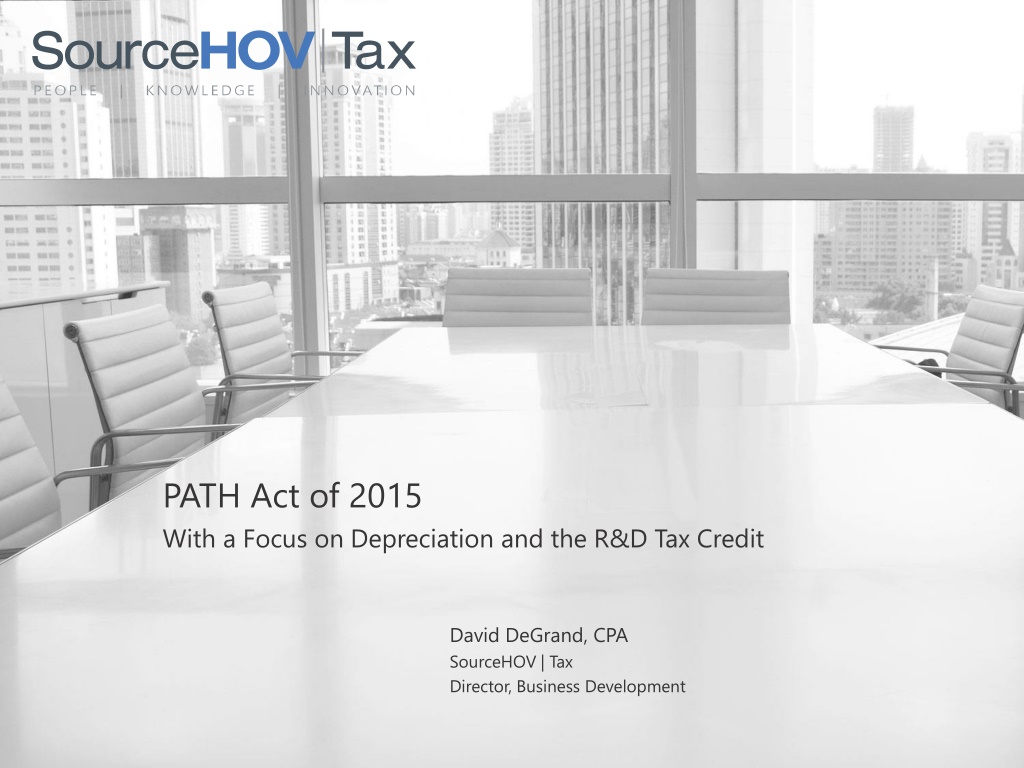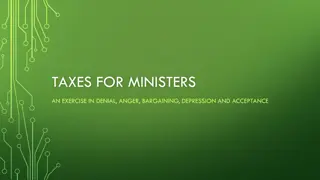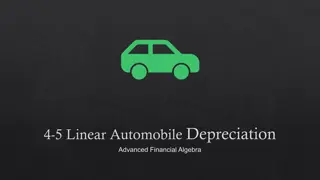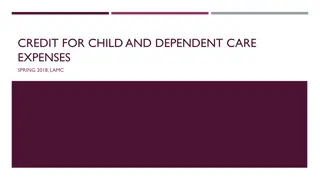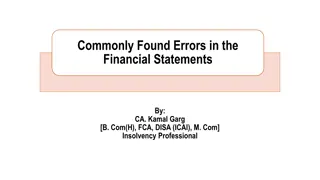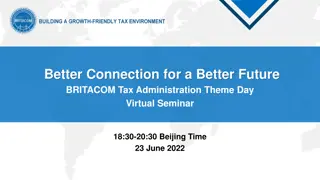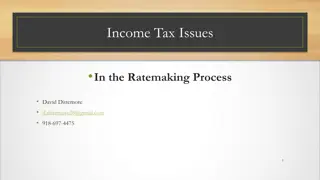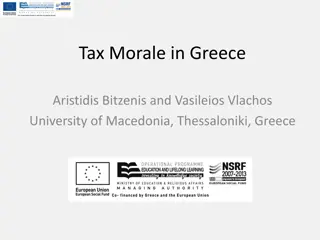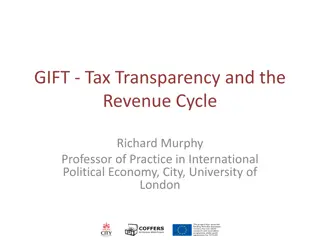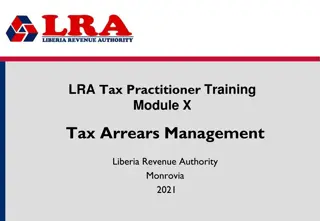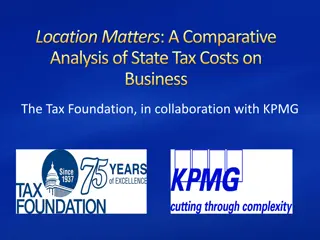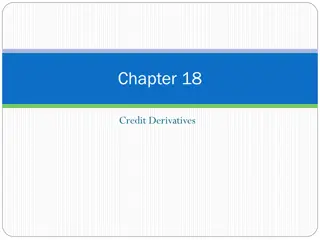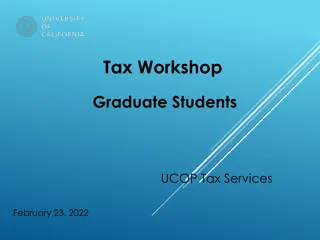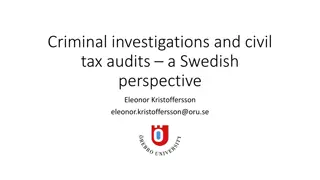Overview of PATH Act of 2015: Depreciation and R&D Tax Credit
The PATH Act of 2015 focuses on depreciation and the R&D Tax Credit, extending approximately 50 taxpayer-favorable tax extenders. It includes enhancements such as 15-year improvement property rules, new bonus depreciation rules, and Section 179 expensing. The Act incorporates permanent provisions like research and development credits, state and local sales tax deductions, and international tax relief measures. Additionally, it outlines five-year provisions related to bonus depreciation and international tax relief rules.
Download Presentation

Please find below an Image/Link to download the presentation.
The content on the website is provided AS IS for your information and personal use only. It may not be sold, licensed, or shared on other websites without obtaining consent from the author. Download presentation by click this link. If you encounter any issues during the download, it is possible that the publisher has removed the file from their server.
E N D
Presentation Transcript
PATH Act of 2015 With a Focus on Depreciation and the R&D Tax Credit David DeGrand, CPA SourceHOV | Tax Director, Business Development
Agenda Protecting Americans from Tax Hikes (PATH) Act of 2015 Extenders Overview R&D Tax Credit Enhancements 15 Year Improvement Property Qualified Improvement Property (QIP) Rules New Bonus Depreciation Rules Section 179 Rules 179D Energy Efficient Deduction 45L Energy Efficient Home Tax Credit 2
Extenders Overview The PATH Act retroactively extends approximately 50 taxpayer-favorable tax extenders. Tax extenders are temporary tax provisions that are routinely extended by Congress on a one or two year basis. The previous tax extenders expired at the end of 2014. 3
Extenders Overview PERMANENT PROVISIONS Research and Development Credit (base credit, 14% ASC, AMT and Payroll provisions) Section 179 expensing ($500,000 and $2 million limits, no limitation on real estate) State and local sales tax deduction 15-year depreciation for qualified leasehold improvements, qualified restaurant improvements, and qualified retail improvements International tax relief: Active finance exception Deduction for teacher classroom expenses 100% exclusion on gains from sale of small business stock Low-Income Housing Tax Credit extenders: the 9% floor and military housing allowance Employer wage credit for employees on active duty (expanded for all employers) All three charitable extenders: food inventory, conservation easements, and IRA charitable rollover, and exemption for certain payments to a controlling exempt organization Both S corporation provisions: 5-year built in gains tax and charitable contributions Mass transit parity Deduction for teacher classroom expenses (indexed for inflation) Enhancements since 2001: Earned Income Tax Credit, Additional Child Tax Credit, and American Opportunity Tax Credit Two provisions for mutual funds: treatment of RIC dividends for foreign investors and subjecting RICs to FIRPTA FIVE-YEAR PROVISIONS Bonus depreciation (50% for 2015-17, 40% in 2018, 30% in 2019) International tax relief: Controlled foreign corporation look-through rule The New Markets Tax Credit The Work Opportunity Tax Credit 4
Extenders Overview TWO-YEAR PROVISIONS Exclusion of discharged mortgage debt relief from gross income (modified) Mortgage insurance premiums treated as qualified residence interest Above the line deduction for qualified tuition and related expenses Indian Employment Tax Credit Railroad Track Maintenance Credit (modified) Mine Rescue Team Training Credit Qualified Zone Academy Bonds Race horses: 3-year recovery period Motorsports complexes; 7-year recovery period Accelerated depreciation for business property on Indian reservations (modified) Election to expense mine safety equipment Film and television expensing (modified to include live theater) Section 199 deduction for activities in Puerto Rico Empowerment Zone tax incentives (modified) Temporary increase in rum cover over American Samoa economic development credit Non-business energy property credit Alternative fuel vehicle refueling property credit 2-wheeled plug-in electric motor credit Second generation biofuel producer credit Biodiesel and renewable diesel incentives credit Indian Coal Production Tax Credit (modified) Credit for facilities producing energy from certain renewable resources Credit for energy-efficient new homes Special allowance for second generation biofuel plant property Energy efficient commercial buildings deduction Special rule for sales or dispositions to implement FERC or State electric restructuring policy for qualified electric utilities Credits relating to alternative fuels Credit for new qualified fuel cell 5
What is the R&D Tax Credit Who Qualifies for the Credit? Companies that are involved in manufacturing, engineering, software development, technical services. What are These Companies Doing that Qualifies? Improving and Product or Process, Using Technology, Looking for New Information, Experimenting. Where Does the Credit Come From? Salaries, Supplies, Contract Labor 6
Who Qualifies for the Credit By Sector Total # Claims 15,873 59 81 67 240 6,219 1,017 58 1,583 304 82 5,280 403 148 278 % of Claims Totals Agriculture, forestry, fishing, and hunting Mining Utilities Construction Manufacturing Wholesale and retail trade Transportation and warehousing Information Finance and insurance Real estate, rental, and leasing Professional, scientific, and technical services Management of companies (holding companies) Administrative/ support and waste management services Various services 0.4% 0.5% 0.4% 1.5% 39.2% 6.7% 0.4% 10.0% 1.9% 0.5% 33.2% 2.5% 0.9% 1.8% 7 sourcehovtax.com Proprietary & Confidential
Who is claiming the R&D credit? 2012 Sales # of credit claims Under $10,000,000 $10,000,000 under $50,000,000 $50,000,000 under $250,000,000 $250,000,000 or more Total 8,105 3,399 2,073 2,295 15,873 Source: Statistics of Income Division: 2012 Corporate Returns Data Total credits in 2012 $10.8 billion Average credit size for companies under $10,000,000 is $89,800 Average credit size for companies $10,000,000 - $50,000,000 is $129,500 8 sourcehovtax.com Proprietary & Confidential
Qualifying R&D Activities The R&D tax credit provides permanent benefits to drive down effective tax rates and generate cash flow. Federal and state incentives are available to companies that devote time and resources to developing new or improved products or processes. Qualifying activities include: experimenting with new materials concept development designing tools, molds and fixtures design prototyping and testing engineering manufacturing processes software development 9 sourcehovtax.com Proprietary & Confidential
Where Does the Credit Come From? Salaries and Wages Typically largest component W-2 Box 1 Wages Three levels of research: Direct Research Direct Supervision of Research Direct Support of Research Supply Costs Used or destroyed during the qualifying activities Includes costs of prototypes ultimately sold Contractor Costs 65% of qualifying costs eligible Salaries & wages Supply costs Contractor costs Credits generally are 5% - 6.5% of QREs 10 sourcehovtax.com Proprietary & Confidential
R&D Credit is Permanent / Enhancements Effective January 1, 2015, the R&D tax credit became permanent. Effective January 1, 2016: The credit will be able to offset Alternative Minimum Tax (AMT) for eligible small businesses, companies with less than $50 million in gross receipts. Start-up companies, whether corporations or partnerships, can apply the credit to offset up to $250,000 in payroll taxes. Start-ups are defined as businesses with less than $5 million in gross receipts in the current year and less than five years of historical gross receipts. 11 sourcehovtax.com Proprietary & Confidential
What Is Cost Segregation: What Does Cost Segregation Do? Identifies Building Components and Site Improvements with Shorter Depreciable Lives. What Are The Benefits? Accelerate Depreciation Which Creates Cash Flow. What Qualifies? Site/Land Improvements, Finish-Out, Mechanical, Electrical When Does It Make Sense? New Construction, Renovations/Leasehold Improvements, Acquisitions, Existing Real Estate 12
15 YEAR IMPROVEMENT PROPERTY 15-year qualified leasehold improvement property (QLHI) , qualified restaurant property (QRP) and qualified retail improvement property (QRIP) Path retroactively extends & makes permanent the inclusion of QLHI, QRIP & QRP in the 15-year MACRS class for property placed in service after Dec. 31, 2014 Under pre-Act law, the 15-year write-off didn't apply to property placed in service after 12/31/14. 1250 Property Associated with Buildings & Real Estate Non-Residential Real Property Residential Real property Site Improvements Qualified Leasehold Improvements (QLHI) Qualified Retail Improvements (QRIP) Qualified Restaurant Improvements (QRP) 39 Year 27.5 Year 15 Year 15 Year 15 Year 15 Year SL SL 150%DB SL SL SL PATH 13
Qualified Improvement Property (QIP) Qualified Improvement Property (QIP): Begins in 2016 Improvements placed in service after original 39-year building; Rules that are similar to Qualified Leasehold Improvement (QLHI) property: Interior portion of a building; Not an elevator or escalator; Not the interior structural framework of the building. Rules that do not follow (QLHI): 3-year rule Lease rule Common area rule QIP does not define a type of 1250 property. It defines which 1250 property receives bonus depreciation QIP bonus applies to all QLHI, all QRIP, and most QRP. It applies to some 1250 improvements that are not QLHI, QRIP or QRP 14
Qualified Improvement Property (QIP) QIP Example s Assumptions; Improvements placed in service after original nonresidential real property building; Interior portion of a building; Not an elevator or escalator; Not the interior structural framework of the building. The building does not qualify when initially placed into service; but, most subsequent interior improvements would qualify, such as; HVAC, Electrical, Partition walls, Doors, Ceilings, Ceramic Tile, Etc 15
Bonus Depreciation 2015 - 2017 2018 2019 2020+ 50% Bonus Depreciation is the same Bonus depreciation drops to 40% Bonus depreciation drops to 30% It disappears after 2019 2015 - 2017 2018 2019 2020+ Starting in 2016, QLHI bonus depreciation is replaced by Qualified Improvement Property bonus depreciation. 16
New Section 179 Rules Retroactive to 2015: Permanently extends the small business expensing limitation and phase-out amounts in effect from 2010 to 2014 ($500,000 and $2 million, respectively). These amounts currently are $25,000 and $200,000, respectively. The special rules that allow expensing for computer software and qualified real property (QLHI, QRP, and QRIP) also are permanently extended. In 2016: $250,000 cap on expensing Qualified Real Property (QLHI, QRP, and QRIP) eliminated Modifies the $500,000 and $2 million business expensing limitation and phase-out by indexing both for inflation Air-conditioning and heating (read: portable) units now qualify for regular 179 Taxpayers can now always use amended returns to make or revoke 179 elections 17
New Section 179 Rules QRP Expensing Limit $100,000 $102,000 $105,000 $125,000 $250,000 $500,000 $500,000 + inflation adj. Phaseout Starts At $410,000 $420,000 $430,000 $500,000 $800,000 $2 million $2 million + inflation adj. Year QRP Limit Deductible? No No No No No Yes Yes 2004 2005 2006 2007 2008-2009 2010-2015 2016+ $250,000 No separate limit 18
Indian Reservation Property Indian Reservation Property Extends accelerated depreciation for qualified Indian reservation property to property placed in service during 2015 or 2016. Previously, Indian Reservation Property was for property placed into service after 1993 and before 1.1.2014 Property Class 3-Year Property 5-Year Property 7-Year Property 10-Year Property 15-Year Property 20-Year Property Nonresidential Real Property Recovery Period 2 Years 3 Years 4 Years 6 Years 9 Years 12 Years 22 Years New irrevocable election out of Indian reservation depreciation on a class-by-class basis starting in 2016 19
Section 45L Section 45L New Energy Efficient Home Tax Credit Extended through 2016 Credit is generally $2,000 per qualifying residence. Claimed by the person who constructed the qualified energy efficient home. Qualification is based on the 2006 International Energy Conservation Code (IECC) and requires a 50% reduction in energy usage. Must be for a dwelling that includes a residence, apartment building, units within a condominium or a houseboat. Dwelling must be complete after 8/8/2005 before 12/31/2016 20
179D Energy Efficiency Deduction Energy Policy Act of 2005 (Notice 2006-52) 50% over ASHRAE 90.1-2001 baseline = $1.80 Lighting 25% = $.60 HVAC 15% = $.60 Envelope 10% = $.60 1. 2. 3. Modeling Required Interim Lighting Allowed EPAct 2008 update (Notice 2008-40) Designers of Government Buildings 21
About SourceHOV Tax Founded in 1983 as LIFO Systems Provide specialty tax consulting solutions nationwide to end clients through our CPA firm partners Perform thousands of LIFO calculations and hundreds of Cost Segregation studies, R&D credit calculations and 179D Energy Efficient studies annually Main market differentiator is our technical expertise and thorough upfront evaluation Project based, turnkey consulting billed at a fixed fee Estimate of benefit and ROI quantified prior to engagement 22 sourcehovtax.com Proprietary & Confidential
David DeGrand, CPA 4150 International Plaza Ste. 650, Fort Worth, TX 76109 817-546-6584 (Office) 817-980-3322 (Cell) david.degrand@sourcehovtax.com 23 sourcehovtax.com Proprietary & Confidential
